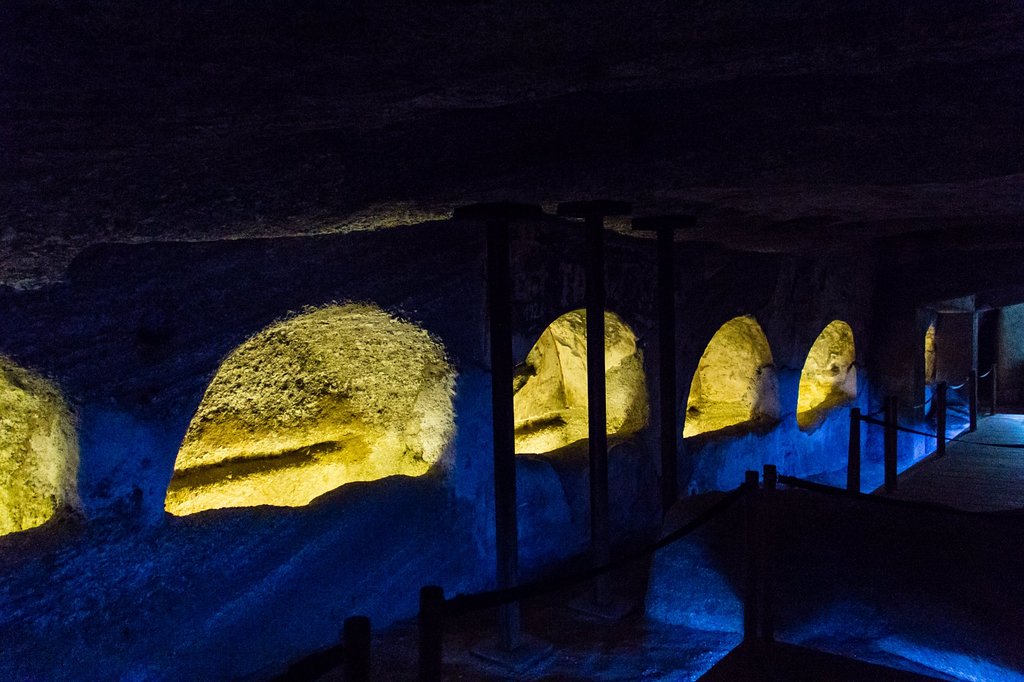
The Catacombs of Milos are an important archaeological site located on a slope, near the village of Tripiti, a short distance from the agora of the ancient city of Melos. The name Tripiti, which means "made with holes", derives from the fact that the surrounding area thrives on natural caves carved into the volcanic rock, which are still used today by the inhabitants as warehouses and stables. In the past these caves were used as burial places and not only. The Catacombs were also the place where the first Christians met to celebrate their cult and became a refuge during the persecution of the Romans.
Datable from the 1st to the 5th century AD the Catacombs of Milos are perhaps even older than the Roman ones and are probably only a small part of an even larger necropolis. They are considered the most important early Christian cult monument in Greece and among the three main Catacombs, of the 74 discoveries around the world, after those of Rome and the Holy Land.
The discovery of the Catacombs of Milos
The looters discovered the Catacombs of Milos in 1840 and stole them. The excavations officially began in 1843 and were undertaken by Professor Ludwig Ross. A German archaeologist and epigraphist, who thanks to his travels, in an age still premature for archaeological excavations, paved the way for the exploration and analysis of the remains of ancient Greece.
To date, three sections of the ancient Catacombs have been discovered, which together with five naves and a burial chamber cover a total length of 183 meters. From the outside it is possible to use only the entrance of the second catacomb, or catacomb "Presviteron". On the graves of the most important people Christian symbols and epitaphs were painted. One of these signs found in the second catacomb is the inscription "Presviteron" from which it derives its name.
On the right and left walls of the Catacombs are the "arcosolia" (arches carved into the rock). A total of 126 arcosoli with different dimensions were found, ranging from 1 to 5 meters wide and from 1.6 to 2.5 meters in height. In addition to the tombs carved into the walls, there are also many tombs dug into the ground and covered with rough stones of irregular size. It is estimated that over 2,000 Christians were buried in the 291 arcosolia and in the floor graves, used as family tombs.
In the Presviteron catacomb there is an additional tomb carved into the rock, similar to a sarcophagus. Probably here was buried one of the first Christian martyrs and was probably used by the first Christians also as the altar for religious celebrations. Some inscriptions on the walls of the Catacombs are still visible, including the Monogram of Christ and the Christian ecumenical symbol "", the cavities used for lamps, as well as votive gifts for the dead, and a couple of tombs of newborns. The use of the catacombs ended after the official establishment of Christianity and the destruction of the ancient city of Klima for the earthquakes of the fifth or sixth century AD
Why visit the Catacombs of Milos?
The Catacombs of Milos are a suggestive place, rich in history, which one certainly does not expect to find on a Greek island. The visit is fast, lasts about ten minutes and is suitable for everyone. We therefore advise you to take a cultural break from your day at sea and to visit the ancient Catacombs of Milos.
A curiosity
From in-depth studies and various tests it is believed that most of the first converts to Christianity on the island were Jews, in fact in Milos there was a substantial Jewish community. Furthermore Professor Gustav Adolph von Deissman, a professor of theology at the University of Heidelberg wrote, concerning St. Paul, of Jewish origin, shipwrecked at Milos on his way to Athens "... his teachings fell like a seed on a fertile soil ".
Useful information to visit the Catacombs of Milos
Visiting hours:
Mon - Sun: 9:00 am - 6:45 pm
Closed on Tuesday
Entrance:
€ 4 for adult adults
€ 2 for children and over 65
Free for EU students